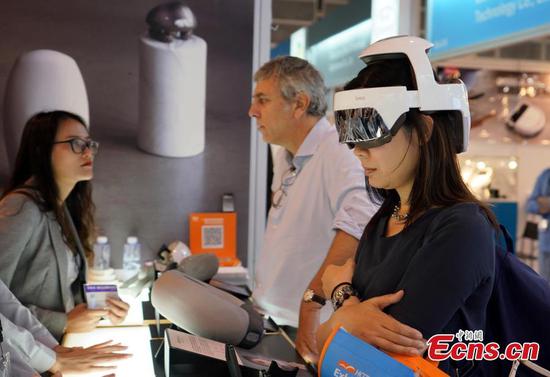Insiders remain calm, saying the new tech needs time to grow
Inside Beijing's downtown area, Xiao Ming, a white-collar worker, was paying for his lunch at a Yoshinoya restaurant and was quick to notice a flat screen displaying the WeChat logo with a facial-payment function.
"Not so many people use it," he was told by the cashier who had seen his inquisitive look.
Indeed, just as facial payment is beginning to make its debut in China's retail stores, some media outlets have pointed out the unpopularity of this tool, primarily due to consumers' concerns over privacy.
Although sales volumes handled by smart payments, inlcuding facial payment and payments in self-service shops, increased by over 90 percent during the National Day holidays, according to a report by Alipay, still hold consumers' concerns about facial-payment technology.
China National Radio reported on October 8 that the utilization rate for terminals seems to be low, citing vendors who have upgraded their point-of-sale gear.
A number of consumers have also expressed their concerns over the safety of such hardware. Vendors, on the other hand, are worried that the deposit payment required for the upgrade may not be a worthy investment and that unnecessary trouble may arise from the use of facial-payment technology.
Alipay plans to land 1 million terminals across China, according to the CNR report.
This was followed by an opinion piece on Nanfang Daily, arguing that a cautious stance should be taken against facial payment. The article described how faked facial graphics had successfully unlocked some payment systems, arguing that if biometric data is lost, people's privacy will be compromised.
The article argued that tech firms, amid their celebrations of this cutting-edge technology, may overlook responsibility in favor of benefits.
Industry insiders and analysts contest that facial payment is new, and it needs time to grow. However, optimistic observers said the new payment method incorporating facial-recognition technology will gain a strong foothold eventually, winning over the market within the next two to three years. It will coexist with existing payment tools.
Facial-recognition payment is touted as one of the leading cutting-edge technologies in China, and it gained serious recognition after Alipay and WeChat Pay, the country's prevailing online payment service providers, began to drive growth in the sector by offering vendors their terminals from the end of 2018.
Alipay, one of China's most popular mobile-payment systems, run by Ant Financial, launched its Dragonfly facial-recognition-powered point-of-sale (POS) system in December 2018 and plans to spend 3 billion yuan ($448 million) to promote the new system across the country, according to media reports.
WeChat Payment's new facial-recognition POS device 'Frog Pro' made its debut at the Smart China Expo in Southwest China's Chongqing Municipality in August.
WeChat, the dominant social-networking app in China, is run by internet giant Tencent. The company has since provided thousands of machines to the market, according to an email statement sent to the Global Times. WeChat has developed 85 types of facial-recognition hardware with its partners.


















































